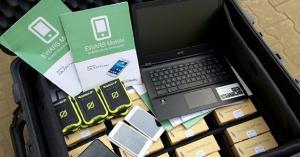A little black box for detecting and tracking outbreaks
One of the toughest tasks in responding to a major public health emergency is getting accurate information about infectious disease outbreaks.
"EWARS in a box" contains all the equipment needed to establish surveillance and response activities, particularly in difficult and remote field settings without reliable internet or electricity.
Infections can spread even more quickly than rumours, particularly when there is a lack of reliable, up-to-date information to detect, track and respond to outbreaks.
Without a rapid response, infectious diseases are more likely to spread in humanitarian settings, putting people’s lives at risk and costing more money and resources in the long run.
WHO’s answer to this problem is in a rugged-looking black suitcase, known as “EWARS in a box”. It’s the product of the Early Warning, Alert and Response System project.
Inside the anonymous looking box is all the equipment needed to set up a disease surveillance system in difficult or remote field settings, within 24 hours. What’s more, it has been configured to work in places without reliable internet or electricity connections.
Flip the locks and, encased in protective grey foam, are two layers of equipment. On top is an ordinary laptop computer, a DataHub about the size of a box of chocolates, and 60 Android mobile phones, all preloaded with some simple, customized software. Underneath this equipment are all the necessary connectors and batteries.
A second, smaller case contains hand-held solar chargers so that the system can run without electricity.
The kit has been specifically designed for maximum mobility. Its size and weight mean that it can be handled by one person and checked in as personal airline baggage.
"The equipment needs to be very simple so we can set the system up as quickly as possible after an emergency occurs," says Dr Chris Haskew, an epidemiologist who was part of the team that created the EWARS box.
"Each phone goes to one health clinic. We assume that each health facility has a catchment of 10 000 people, so one EWARS kit can cover half a million people, which is a significant emergency affected area or displacement camp."
Once an EWARS box is on-site, the first job is to create an account and customize it for the specific emergency – language, locations, users, diseases to be monitored, data required, reporting frequency, etc.
The customized form is then automatically loaded onto the mobile phones that are given to local health workers, who can immediately begin collecting information. Data gatherers can also use their own Android phones by downloading the app from the Google Play Store. Completed forms are automatically sent back via mobile signal to the DataHub, which is kept at the nearest emergency operations centre.
This box allows the system to run entirely offline, so WHO and Ministry of Health staff are rapidly alerted to potential outbreaks. The system crunches the numbers into automated reports that can be shared almost in real time with partners in the field, and sent to WHO offices anywhere in the world.
The system does more than just collect data, Dr Haskew explains. "There are three parts to EWARS. For the early warning, it collects weekly data and publishes it as a bulletin. Another function is to generate and manage alerts, which are then verified and, where necessary, escalated to rapid response teams who assess the level of risk. The third element is outbreak response. If an alert is confirmed as a real outbreak, then we need to collect more detailed data on individual cases. This can be done through the same app by configuring and issuing another form directly to the phones of our frontline users."
For example, with highly-infectious diseases like measles, one case triggers an alert. Other diseases like malaria have a moving average. Once an alert is triggered, phone notifications are sent, and verification and risk assessment procedures are set in motion.
The app enables health responders to access and operationalize WHO guidance in the field, such as assigning a level of risk to an alert based on a recommended risk matrix. The system also works in remote locations, where there is no mobile coverage.
"There are places, such as in South Sudan, where you walk for a day to get the information. There, you may not be on a mobile network. But the phone stores the data and, as soon as it finds a connection, perhaps from the top of a hill, then it automatically syncs."
In addition to internet and mobile phone coverage, the other major hurdle the EWARS creators faced was patchy power connections. So, the field equipment – the phones – can use solar chargers.
The EWARS kit was first deployed in South Sudan in 2015, and it is “still running well”, despite the tough conditions, according to Dr Haskew. "We used to see completeness rates of 20-30% in the previous system, which also faced lengthy delays in receiving and analysing reports at the central level. So far in 2017, overall completeness of reporting is over 70% and we are able to publish bulletins automatically each week."
Since then it has been used in Chad, Ethiopia, Fiji, Nigeria and Yemen, with more deployments planned in Iraq, northern Syria, the Solomon Islands and Vanuatu. Each kit costs around US$15 000.



